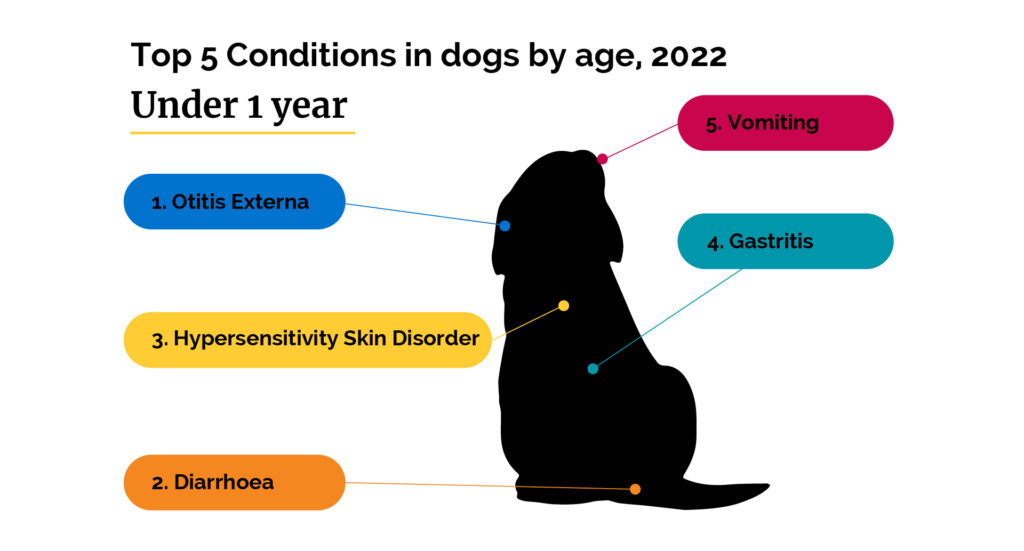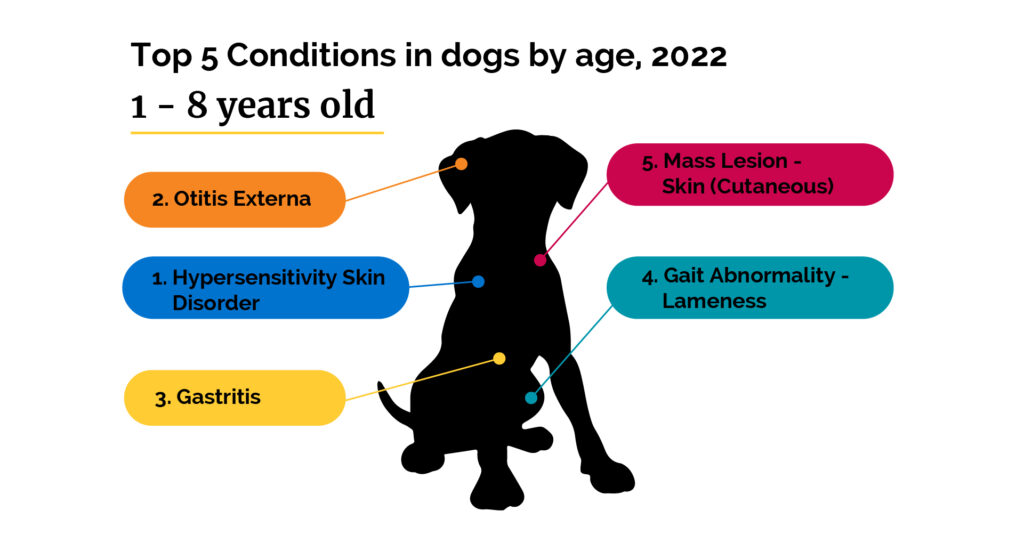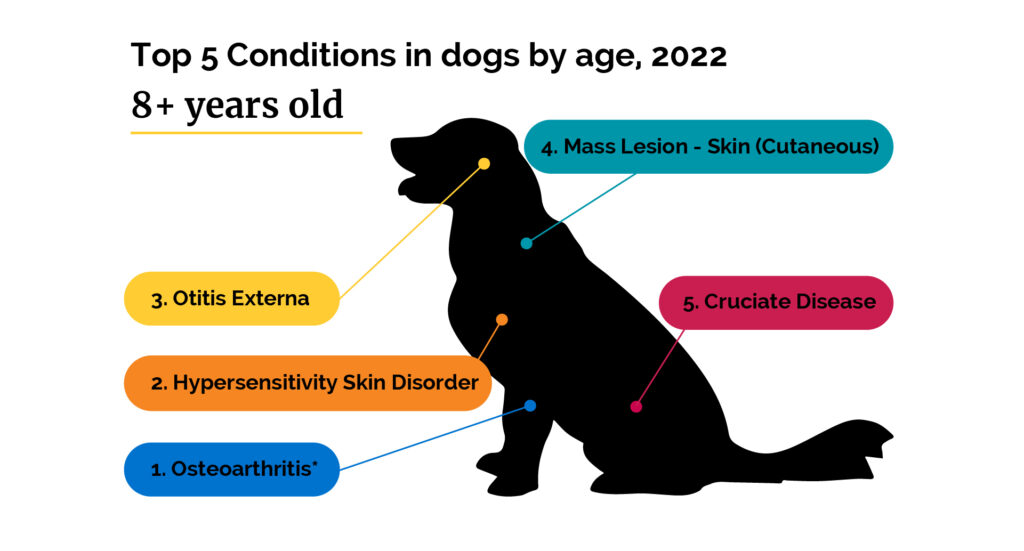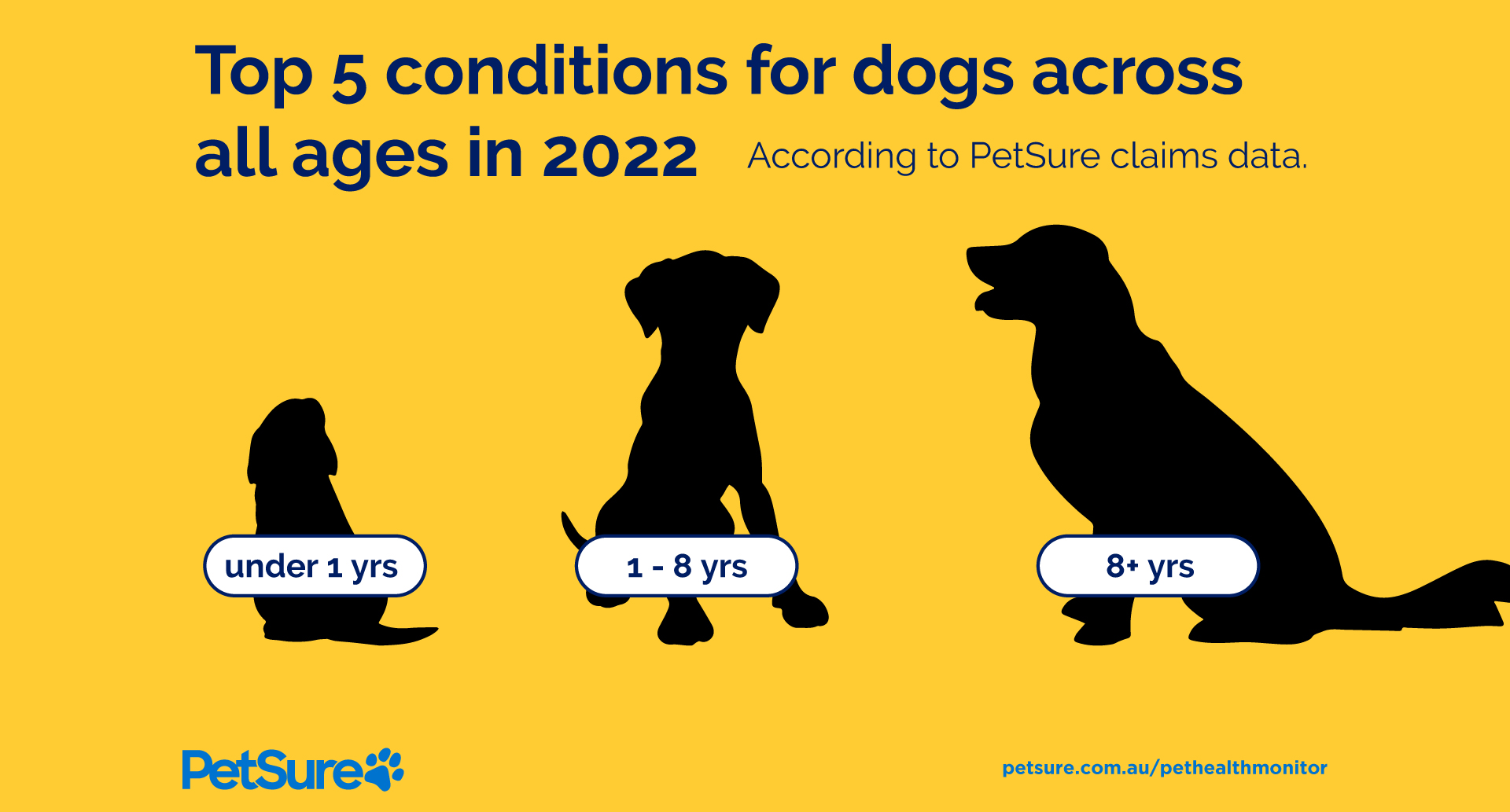
Puppies and young dogs are exploring the world so it may not be surprising that gastrointestinal problems like diarrhoea, vomiting and gastritis (inflammation of the stomach lining) are common. Ear infections and skin irritations are also conditions that affect this age group of dogs.
1. Ear infection (otitis externa)
2. Diarrhoea
3. Skin allergies
4. Gastritis
5. Vomiting
Ear infections
Outer ear infections, also known as otitis externa, are a common infection in dogs of all ages. Ear infections are typically painful and irritating. Affected dogs frequently shake their heads and rub and scratch their ears. The ears become red, swollen and will often produce an unpleasant smell. This may be accompanied by a dark or yellowish discharge. In cases of persistent inflammation, the ears may appear crusty or swollen, and the ear canals may become narrow (also known as stenotic).
Black discharge, scratching, and head shaking are a few symptoms of ear mites. Puppies are more likely to get ear mite infections than bacterial infections. Although the environment that ear mites produce in the ear canal promotes the development of a secondary bacterial or fungal infection.
In adult dogs, ear infections can be exacerbated by underlying allergic skin disease, structural changes to the ears (due to chronic inflammation or hereditary issues) foreign bodies, or polyps/masses. The veterinarian will examine the ear canal to check for these infections, and to make sure the ear drum is intact. They will also typically take a swab to check if any organisms are growing within the ear which can help identify the best course of treatment.
Preventing or monitoring for ear infections at home can include ensuring parasite treatment is up to date, cleaning ears whenever the dog goes swimming, and keeping the ears off floppy eared breeds as dry as possible. Treating underlying skin allergies can also be a vital way to help prevent ear infections in dogs.
Diarrhoea
Diarrhoea in dogs has numerous causes ranging from minor dietary indiscretions through to fatal viruses like canine parvovirus or even cancers. The age and duration of the dog can help narrow down the cause of the diarrhoea.
In puppies, diarrhoea can be caused by parasites such as worms, viruses and bacteria, or can be due to changes in diet causing a simple tummy upset or indigestion. Young and curious dogs may also be more likely to delve into rubbish bins, taste test household plants or overeat which can result in diarrhoea. Often, in these cases the true cause may never be known, and treatment can be symptomatic.
As diarrhoea is a sign of parvovirus, it’s a good idea to have your puppy checked by a vet if it lasts longer than a day, if it’s watery or has blood in it. Preventing diarrhoea in young dogs may not always be possible. Here are some practical ways to help reduce the risk of tummy upsets:
- Introduce new foods gradually by mixing a small amount of the new food with the old food
- Avoid giving young dogs cow milk, as dogs are often lactose intolerant, and this can result in diarrhoea.
- Ensure intestinal worming prevention is up to date.
- Practice good hygiene around the home. Wash bowls daily with hot soapy water and allow them to dry completely. Ensure water is fresh daily. Always pick up poos from the garden as soon as possible.
- Store medications, cleaning products and any other household toxins away from pets
- Ensure vaccinations are up to date.
- Keep all rubbish, food scraps and human foods away from dogs.
- Only expose your young dog to trusted dogs who are fully vaccinated, and avoid dog parks or areas where they could come in contact with unvaccinated dogs or other dog’s waste.
3. Allergic Skin Disease
An allergy is a condition where the immune system is overly sensitive or reactive to a specific substance known as an allergen. Proteins from plants, insects, animals or foods are common allergens in dogs.
After exposure to an allergen, the body can start to overreact, and this is what brings on an allergic reaction. Skin allergies in dogs are very common and can range from minor itchiness or redness right through to chronic, severe or ongoing skin disease with underlying allergies as the cause.
Allergies can be complicated to diagnose as they require ongoing, long-term treatment. Allergies can pose a welfare risk in affected pups, as being chronically itchy is very uncomfortable. Broken skin from scratching sets up a perfect environment for secondary bacteria to take hold.A common cause of hypersensitivity reactions in dogs is flea bites, so ensuring your dog is flea free all year round is one way to help reduce the risk of allergies. As allergic skin disease is often ongoing, working closely with your vet is essential to help keep your pup itch free and happy. Read more on what Atopic Dermatitis is and how you can treat it here.
4. Gastritis and Vomiting
Gastritis is the inflammation of the stomach lining and is very common in dogs. When gastritis is acute or persists more chronically, it can be a sign that there is something more serious going on.
Vomiting is a key sign of gastritis and so gastrointestinal problems which include vomiting and gastritis will be addressed in this section. In most cases acute vomiting and gastritis in dogs is transient and lasts for a day or so before resolving. This means that the underlying cause is often not identified. Eating raw or rotten food, garbage bins, plants, toxins, fungior things like kitty litter can cause vomiting and gastritis. Sudden changes of diet or feeing human food to dogs can also cause stomach upsets. Some dogs may even overeat to a point where vomiting and gastritis occur. Chronic gastritis can be a sign of an underlying problem which can include things like pancreatitis, cancers, autoimmune diseases, foreign body obstructions, endocrine (hormonal) diseases and food intolerances. Preventing vomiting and gastritis ultimately will depend on the underlying cause, but for dietary causes it may be possible to reduce the risk of developing vomiting and gastritis with the following:
- Provide them with excellent, premium dog food and avoid things with by-products, artificial colours, flavours and fillers
- Stay up to date with intestinal worming to rule out parasitic causes of gastrointestinal upsets
- Avoid snacks that your dog might not be used to or that could contribute to tummy upsets
- Seek out veterinary advice early and follow their directions which may include hypoallergenic food trails, blood tests, ultrasounds, other imaging, and /or medications.
- Observe dogs closely on walks and make sure they aren’t eating things they shouldn’t
- Avoid sudden changes of diet
- Feed to the recommended amount and don’t allow dogs to over eat
- Make sure bins, kitty litter and plants are well out of reach

As dogs become older, allergic skin disease and ear infections still dominate the top claimed health conditions in 2022 according to PetSure claims data. Atopic dermatitis is seen more frequently in this age group. With wear and tear on the body, lameness can develop. Age also means that the frequency of skin lumps and bumps increases.
1. Skin allergies
2. Ear infection
3. Gastritis
4. Lameness
5. Skin masses
Lameness
Lameness is often referred to as a limp and is generally due to pain or injury to one or more limbs, or the spine. Dogs love to run and play, so it’s not uncommon for them to have sprains, strains, broken bones, broken toenails, dislocations, or other injuries that result in pain and limping.
It is important to remember is that limping is a sign that there is something that may be wrong. As there are many causes for limping, which can include simple injuries, complex injuries, tumours, and other serious problems, having your dog checked by your vet is the first point of call. Elbow dysplasia, hip dysplasia, luxating patellae, and cruciate ligament disease are all causes of lameness that typically won’t resolve with conservative treatments.
Arthritis and bone tumours are also causes of lameness that affect older dogs which require special attention. Preventing lameness can be tricky but avoiding stop/start games (such as ball throwing), keeping nails trimmed short and keeping dogs lean and fit can help reduce the risk of certain types of lameness.
2. Skin masses
Lumps and bumps on dogs’ skin could be a sign of something sinister. There are a wide range of lumps that may present on the skin of dogs, and it isn’t always possible to tell what they are simply by looking at them, which is why it’s important to consult your local vet.
When checking skin masses in dogs, often the vet will need to take a sample of the cells by an aspirate through a needle, a biopsy, or simply removing the whole mass. It’s important to remember that lumps and bumps are not normal. This means that sometimes having a mass surgically removed which turns out to be benign is still effort well spent in ruling out a potentially life-threatening disease.
Skin cancers in dogs include melanoma, mast cell tumour, squamous cell carcinoma, sebaceous adenomas, and hair follicle tumours. Other common masses affecting dogs skin include papilloma, histiocytoma, acrochordon and follicular cysts. Often mistaken for a skin lesion, lipoma is a fatty tumour that is common in older and overweight dogs.
While it may not be possible to prevent many skin masses from occurring, early diagnosis is key to successful treatment so if you notice any lumps or bumps on your dogs’ skin, have them checked out as soon as possible.

In senior dogs, arthritis takes the top spot of health conditions affecting this age group. Another degenerative disease seen in this age group is cruciate ligament disease. Allergies, ear infections and skin masses are still common in dogs aged eight years or older.
1. Arthritis
2. Skin allergies
3. Ear infections
4. Skin masses
5. Cruciate ligament disease
Cruciate ligament disease
Cruciate ligament disease is a condition affecting the stabilising cruciate ligaments within the stifle (knee). The injury may be to the cranial (front) cruciate ligaments or the caudal (rear) cruciate ligaments.
Cruciate ligament disease may occur secondary to acute injury but is often degenerative. It may be referred to as cruciate ligament rupture/tear, cranial cruciate ligament disease or caudal cruciate ligament rupture. The injury to the ligament may be described as a complete or a partial tear. While large breed and giant breed dogs are generally more at risk of cruciate ligament disease, any breed of dog can be affected. Preventing cruciate ligament disease can be tricky but avoiding stop/start games (such as ball throwing), keeping nails trimmed short and keeping dogs lean and fit can help reduce the risk of cruciate ligament disease.
As dogs get older, they may become susceptible to different types of health conditions. Educate yourself on the common signs of health issues so you can take care of your furry friend, and get them expert advice when needed.
Pet insurance can help by covering a portion of the eligible vet bill if the unexpected happens. Because it is difficult to predict the costs of veterinary care, it can help to have measures in place to help prepare for the unexpected. Check out our partner network and explore our policy tools to find a pet insurance policy.
Not all conditions or items are covered by Pet Insurance. Refer to the applicable Product Disclosure Statement for information about coverage and exclusions.



 Fact checked
Fact checked





